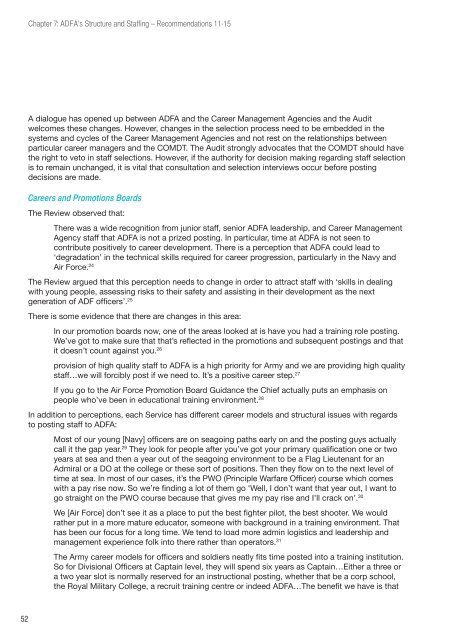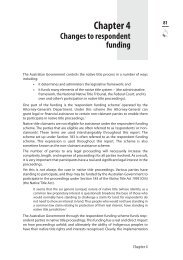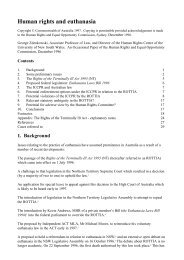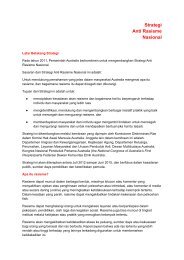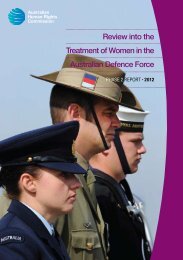Review into the treatment of women at the Australian Defence Force ...
Review into the treatment of women at the Australian Defence Force ...
Review into the treatment of women at the Australian Defence Force ...
- No tags were found...
Create successful ePaper yourself
Turn your PDF publications into a flip-book with our unique Google optimized e-Paper software.
Chapter 7: ADFA’s Structure and Staffing – Recommend<strong>at</strong>ions 11-15A dialogue has opened up between ADFA and <strong>the</strong> Career Management Agencies and <strong>the</strong> Auditwelcomes <strong>the</strong>se changes. However, changes in <strong>the</strong> selection process need to be embedded in <strong>the</strong>systems and cycles <strong>of</strong> <strong>the</strong> Career Management Agencies and not rest on <strong>the</strong> rel<strong>at</strong>ionships betweenparticular career managers and <strong>the</strong> COMDT. The Audit strongly advoc<strong>at</strong>es th<strong>at</strong> <strong>the</strong> COMDT should have<strong>the</strong> right to veto in staff selections. However, if <strong>the</strong> authority for decision making regarding staff selectionis to remain unchanged, it is vital th<strong>at</strong> consult<strong>at</strong>ion and selection interviews occur before postingdecisions are made.Careers and Promotions BoardsThe <strong>Review</strong> observed th<strong>at</strong>:There was a wide recognition from junior staff, senior ADFA leadership, and Career ManagementAgency staff th<strong>at</strong> ADFA is not a prized posting. In particular, time <strong>at</strong> ADFA is not seen tocontribute positively to career development. There is a perception th<strong>at</strong> ADFA could lead to‘degrad<strong>at</strong>ion’ in <strong>the</strong> technical skills required for career progression, particularly in <strong>the</strong> Navy andAir <strong>Force</strong>. 24The <strong>Review</strong> argued th<strong>at</strong> this perception needs to change in order to <strong>at</strong>tract staff with ‘skills in dealingwith young people, assessing risks to <strong>the</strong>ir safety and assisting in <strong>the</strong>ir development as <strong>the</strong> nextgener<strong>at</strong>ion <strong>of</strong> ADF <strong>of</strong>ficers’. 25There is some evidence th<strong>at</strong> <strong>the</strong>re are changes in this area:In our promotion boards now, one <strong>of</strong> <strong>the</strong> areas looked <strong>at</strong> is have you had a training role posting.We’ve got to make sure th<strong>at</strong> th<strong>at</strong>’s reflected in <strong>the</strong> promotions and subsequent postings and th<strong>at</strong>it doesn’t count against you. 26provision <strong>of</strong> high quality staff to ADFA is a high priority for Army and we are providing high qualitystaff…we will forcibly post if we need to. It’s a positive career step. 27If you go to <strong>the</strong> Air <strong>Force</strong> Promotion Board Guidance <strong>the</strong> Chief actually puts an emphasis onpeople who’ve been in educ<strong>at</strong>ional training environment. 28In addition to perceptions, each Service has different career models and structural issues with regardsto posting staff to ADFA:Most <strong>of</strong> our young [Navy] <strong>of</strong>ficers are on seagoing p<strong>at</strong>hs early on and <strong>the</strong> posting guys actuallycall it <strong>the</strong> gap year. 29 They look for people after you’ve got your primary qualific<strong>at</strong>ion one or twoyears <strong>at</strong> sea and <strong>the</strong>n a year out <strong>of</strong> <strong>the</strong> seagoing environment to be a Flag Lieutenant for anAdmiral or a DO <strong>at</strong> <strong>the</strong> college or <strong>the</strong>se sort <strong>of</strong> positions. Then <strong>the</strong>y flow on to <strong>the</strong> next level <strong>of</strong>time <strong>at</strong> sea. In most <strong>of</strong> our cases, it’s <strong>the</strong> PWO (Principle Warfare Officer) course which comeswith a pay rise now. So we’re finding a lot <strong>of</strong> <strong>the</strong>m go ‘Well, I don’t want th<strong>at</strong> year out, I want togo straight on <strong>the</strong> PWO course because th<strong>at</strong> gives me my pay rise and I’ll crack on’. 30We [Air <strong>Force</strong>] don’t see it as a place to put <strong>the</strong> best fighter pilot, <strong>the</strong> best shooter. We wouldra<strong>the</strong>r put in a more m<strong>at</strong>ure educ<strong>at</strong>or, someone with background in a training environment. Th<strong>at</strong>has been our focus for a long time. We tend to load more admin logistics and leadership andmanagement experience folk <strong>into</strong> <strong>the</strong>re ra<strong>the</strong>r than oper<strong>at</strong>ors. 31The Army career models for <strong>of</strong>ficers and soldiers ne<strong>at</strong>ly fits time posted <strong>into</strong> a training institution.So for Divisional Officers <strong>at</strong> Captain level, <strong>the</strong>y will spend six years as Captain…Ei<strong>the</strong>r a three ora two year slot is normally reserved for an instructional posting, whe<strong>the</strong>r th<strong>at</strong> be a corp school,<strong>the</strong> Royal Military College, a recruit training centre or indeed ADFA…The benefit we have is th<strong>at</strong>52


